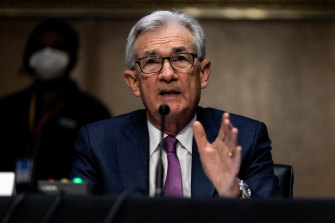One fund he’s following is the Invesco S&P 500 Pure Value ETF, which invests in value stocks of the S&P 500, with about 40 per cent of the fund’s holdings coming from the financial services sector.
Stocks that could suffer from higher rates include shares of small, emerging software and e-commerce companies and other capital-intensive tech firms that have depended on borrowing heavily at low rates until they can turn profitable, Kapyrin said.
“You can always find a good reason to sell when there’s a lot of uncertainty. But the markets bounce back faster than people might expect.”
Morningstar portfolio strategist Amy Arnott
One fund focused on interest rates is the ProShares Equities for Rising Rates ETF, which is restricted to sectors that historically outperform the market when rates are rising. About 80 per cent of its holdings are in the financial, energy and material sectors. For a more defensive stance, there’s the ProShares S&P 500 Dividend Aristocrats ETF, a fund of stocks with growing dividends that can offset the effects of inflation and rising rates.
Amy Arnott, a portfolio strategist with Morningstar, strongly warned investors against dumping stocks and moving into cash. The paltry returns on bank deposits and money market funds won’t necessarily improve with the Fed’s rate increases and, even if they did, they still wouldn’t beat inflation, resulting in a loss in terms of real dollars. Even worse, bailing out of stocks raises the much more difficult challenge of deciding when to get back in.
“You can always find a good reason to sell when there’s a lot of uncertainty,” Arnott said, “but the markets bounce back faster than people might expect.”
She said it was important not to overlook consumer staples and assume that inflated operating costs will trim corporate margins. The reality is that those companies are able to pass their increased costs on to consumers, with some companies using inflation to hide additional price increases.

As well as the Ukraine war, markets have just as close an eye on what the Fed is doing.Credit:Bloomberg
“Consumer staples tend to hold up real well whenever there’s a lot of volatility in the market,” Arnott said.
Investors should also pay closer attention to bond funds, several analysts said. Bonds serve as an important stabiliser in a diversified portfolio, but today’s rising interest rates hurt the value of existing lower-rate bonds. That trend will reverse as the old bonds mature and are replaced by new, higher-rate bonds. Already, yields on five- and 10-year corporate bonds are near 4 per cent.
“There’s a lot of talk about, ‘Rates went up and my bond fund values went down,’ but your bond fund now gets to reinvest your money at a higher return,” McMillan said.
One move that doesn’t involve making any drastic changes is a simple one, said Leanna Devinney, vice president of the Fidelity investor centre: rebalance your holdings.
Loading
“During volatile markets, your asset diversification can shift, and rebalancing gives you an opportunity to manage risk and to keep your investments aligned,” Devinney said.
“We want to buy low and sell high, and rebalancing is a great way to do it.”








